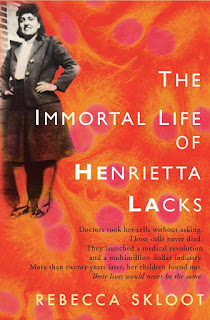 |
My Rating: 3.5 out of 5Buy on Amazon (affiliate) |
The Immortal Life of Henrietta Lacks by Rebecca Skloot investigates the history of the oft-uncredited woman behind the most widely used cells in science. Skloot spent over a decade researching Hentrietta Lacks, who died from cervical cancer at the age of thirty-one; the Lacks family, who was unaware that the cancer cells had been taken and used for research purposes for decades; and the ethical implications surrounding the use of human biological tissues in medical research.
While the scientific nature of the book's subject might put off potential readers, the story is anchored by the wonderful, heartfelt characterization of the Lacks family. Much of the book explores the Lacks children's mistreatment, pain, anger and confusion surrounding the loss of their mother and the commercialization of their DNA through HeLa without being provided any information, acknowledgement or potential for compensation. The book also examines the ongoing debate about the collection, storage and use of tissues that a patient "discards" during diagnostic and treatment procedures. There is much contention over the necessity of informing patients of the use of their cells after removal from the body and how to go about that in a legal system that historically has favored scientists' need to access large quantities of human tissues in order to conduct research that fuels medical advancements.
Although parts of the book where incredibly engaging, particularly in the beginning, my reading enjoyment did suffer from a slower pace later on. I think the book probably could have been whittled down a bit as I felt quite bored trudging through sections where there seemed to be some overlap of information already covered. I found the disjointed narrative style unappealing as well, but I understand it was probably the most suitable choice to cover the issues of race, class, and ethics from different perspectives. I have to admit I was surprised by how readable and informative the scientific aspects were described in this book. When dealing with biology and genetics, things can get complicated but the author left it simple enough that high school students could understand. The legal and ethical discussions were very interesting as well, especially in the afterward. Overall, I would say this is a very informative book with a fascinating story and it is a very worthy read despite some editorial choices I didn't like.
Here's hoping that the upcoming HBO movie adaptation starring Oprah Winfrey does justice to this important story.
FINISHED BOOKS:
#1 - The Immortal Life of Henrietta Lacks by Rebecca Skloot
NEXT BOOK: #2 - Hedy's Folly: The Life and Breakthrough Inventions of Hedy Lamarr by Richard Rhodes